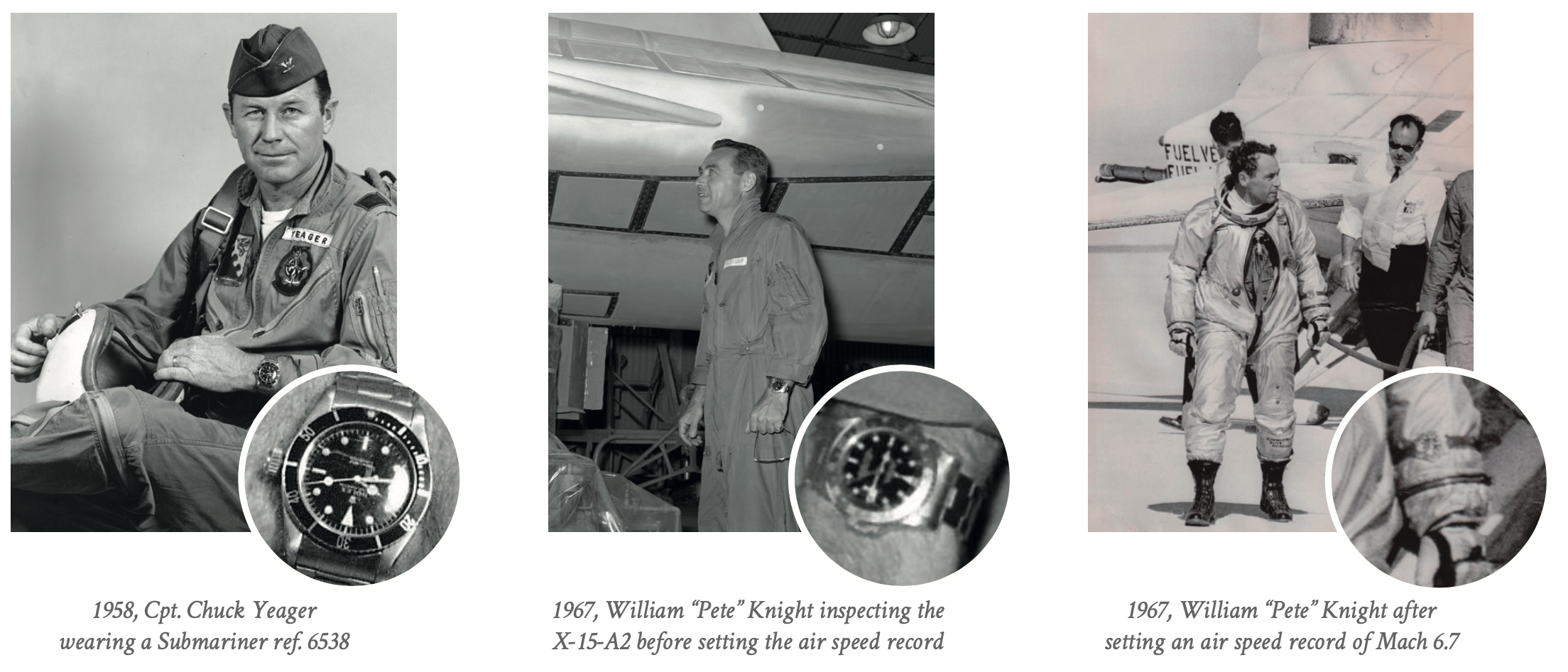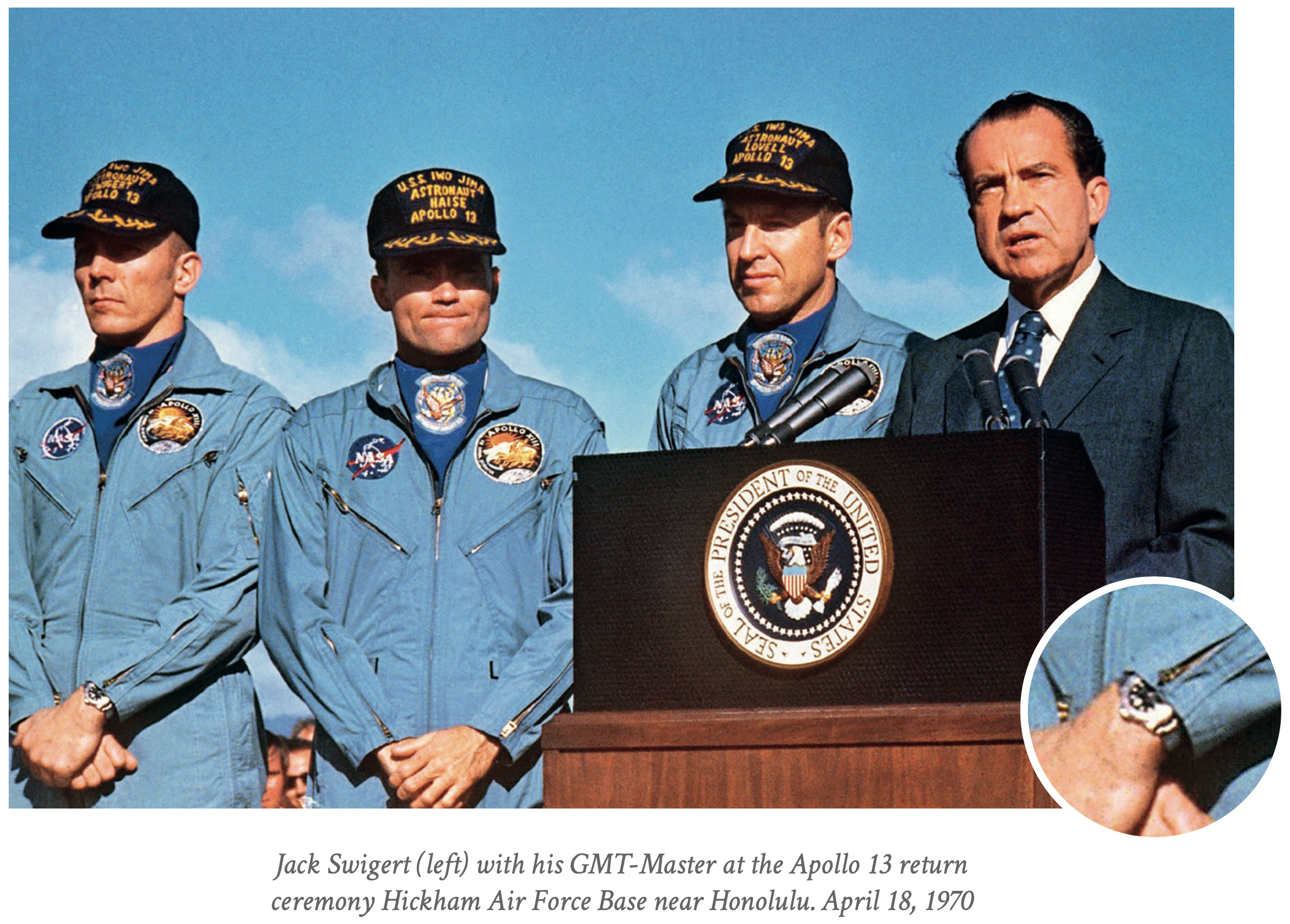This week, I’m thrilled to be able to publish an (exclusive!) excerpt from the excellent book The Vintage Rolex Field Guide by Colin White. To purchase the book, head to Amazon.
By: Colin A. White (excerpt from The Vintage Rolex Field Guide)
If you’re interested in acquiring a vintage tool Rolex, you will quickly learn about the nautical, aviation, and mountaineering history. The role played by Rolex in early spaceflight is often overshadowed by Omega and the iconic Speedmaster. From early supersonic test flights to the last of the NASA space shuttles, a Rolex wristwatch has been present. Favored by Soviet cosmonauts too, Rolex watches have served time on the Internation Space Station and other orbital missions.
The story begins on October 14th, 1947, a white cream dial Rolex Oyster literally skyrocketed on the wrist of Charles “Chuck” Yeager as he became the first pilot to break the sound barrier in level flight. During the rest of his career, Yeager turned out to be a die-hard fan of Rolex watches as he wore consecutive models such as a Submariner 6538 (1958), a GMT-Master 6542 (1962), and a GMT-Master 1675 (1971).
By 1950, Rolex had perfected some game-changing firsts in the world of horology, such as a reliable automatic movement with a date complication. Rolex watches were appearing on the wrists of world leaders such as Sir Winston Churchill and US President Dwight Eisenhower. [Hans] Wilsdorf’s strategy of pairing top-quality product development with rugged use by joint military services and scientific expeditions burnished an increasingly prestigious reputation. The accuracy and durability of Rolex led to the tool watch concept aimed at specific professions like engineers, divers, explorers, pilots, and astronauts.
In 1953, as commercial jet aviation matured, Rolex was asked by several airlines to design a wristwatch to fit the needs of aircrew and world travelers. Pan American Airlines and Rolex teamed up to develop a suitable timepiece that could simultaneously display time in two different time zones.
In 1954, Rolex launched the GMT-Master wristwatch. It featured a red and blue 24-hour bezel, a black dial, a date function, and a fourth 24-hour hand. This was differentiated by a distinctive luminous triangle at its tip. This Greenwich Mean Time (GMT) hand enabled flight crews to set the watch to another time zone by using the rotatable 24-hour bezel and setting it to the correct offset.
The Rolex GMT-Master was quickly adopted by many airlines as the GMT standard was required for all aviation planning and navigation. The 1960s Rolex catalog heavily publicized the fact that both pilots and navigators considered the watch an important professional aid.
That same year the GMT-Master 1675 model became available, featuring protective crown guards. it was built for the purpose of timekeeping for the cockpit crew. This popular red and blue Pepsi-bezel watch remained available through 2007, and caught the eye of both American astronauts and Russian cosmonauts along the way.
In 1959, the United States Air Force started operations of the X-15 rocket-powered aircraft in NASA’s hypersonic research program. The goal was to acquire research data to guide aircraft and spacecraft design.
In 1963, as NASA started recruitment for the Group III astronauts, Mercury astronaut John Glenn’s goodwill tour brought him to Japan. He was met with good public enthusiasm and the event was noticed by Rolex. The company had wanted to release a watch in tribute to the brave spacefarers of the time, as it had done to commemorate expeditions to the summit of Mount Everest and the Arctic.
In response to the Japanese fascination with astronauts and space-related science fiction, Rolex launched a small production run of the “Space Dweller”, which was a modified version of the Explorer model. This model remained a Japan-only special edition and was not released to Rolex’s world market.
On June 1, 1964, after four months of rigorously testing three watch brands, NASA’s Gemini & Flight Support Procurement Office adopted the Omega Speedmaster as its official flight-qualified timepiece. This model was to be christened “the Moonwatch” in July 1969. Although Rolex missed out on a historic advertising opportunity, their watches were to make it into both American and Soviet-Russian space programs.
Astronauts and test pilots privately purchased Rolex wristwatches, demonstrating a strong preference for the GMT-Master reference 1675. By 1965, Mercury astronaut Scott Carpenter became an aquanaut, joining the US Navy Sealab II project to test underwater habitats and advance the science of deep-sea exploration. During this time, he wore a Rolex Submariner and later, a Rolex Sea-Dweller, the first wristwatch designed for saturation diving.
In June 1967, test pilot William “Pete” Knight was pictured wearing a Rolex GMT-Master while inspecting the ablative white coating on the X-15-A2 rocket-powered research aircraft. On October 3, 1967, Knight piloted this particular aircraft at a speed of Mach 6.7, a record that remains unchallenged today. Pete Knight’s next X-15 flight on October 17, 1967 brought him to an altitude of 85.5km, high enough to be awarded the USAF astronaut wings. Post-flight photos revealed that he was wearing his Rolex GMT-Master on both of these X-15 flights.
Rolex and the Apollo Moon Program
In 1968 and 1969, several Apollo program astronauts were seen wearing Rolex wristwatches during training activities. These included Walter Schirra, Frank Borman, James Lovell and Michael Collins. However, the first Rolex flown aboard an Apollo was worn by Apollo 13 Command Module Pilot John “Jack” Swigert.
Apollo 13
Just 72 hours prior to the Apollo 13 launch, Swigert replaced Ken Mattingly and was photographed wearing his personal Rolex GMT-Master while discussing details with Deke Slayton. April 11, 1971 Apollo 13 suit-up photos show Swigert wearing his personal Rolex with a bracelet on his left wrist underneath his spacesuit.
On April 13, 1970, Swigert spoke the now famous words, “Houston we’ve had a problem.” Three days later on April 16, he used his Speedmaster to time the lunar module DPS (descent propulsion system) engine burn at 04:31:28 to :42. Upon their return to Earth, Swigert gifted his space-flown Rolex to Rolex Public Relations Direct, Rene-Paul Jeanneret, who offered Swigert a golf black bezel GMT-Master on a jubilee bracelet. In December 1971, Jack Swigert finally posed for his official white spacesuit portrait wearing this gold watch.
Apollo 14
Between August 1969 and November 1970, the Apollo 14 crewmembers were pictured wearing Rolex GMT-Master watches during geology training as they prepared to bring moon rocks to Earth. NASA astronauts were allowed to carry private items in their personal preference kit (PPK), along with other small personal effects including wristwatches. Some of these fireproof-PPK bags were stored in the Command & Service Module (CSM), while others hung in the Lunar Module (LM). The latter descended to the lunar surface, rendering the items LM-flown.
During the suit-up procedures on January 31, 1971, both Command Module Pilot Stuart Roosa, and Lunar Module Pilot Edgar Mitchell, were seen wearing Rolex GMT-Master watches. Moreover, Ed Mitchell had a pair of Rolex GMT-Master 1675 watches, tucking one on each wrist under the inner cuff of his A7L spacesuit. Although both Roosa and Mithcell clearly wore the Rolex in the CSM “Kitty Hawk”, there’s no footage showing Mitchell wearing the watches aboard the lunar module “Antares”, not on the lunar surface.
Apollo 17
In 1972 during the November 21 lunar EVA-training at Cape Canaveral, Apollo 17 Commander Eugene Cernan was pictured wearing a Rolex GMT-Master strapped over the left forearm of his A7LB space suit. A few months later in December, Apollo 17 Command Module Pilot Ronald Evans was the last to account for a space-flown Rolex watch during the Apollo program. During the mission, Evans asked his moonwalking colleagues, Gene Cernan and Harrison Schmitt, to take his PPK-bag containing a private Rolex GMT-Master, aboard LM “Challenger” down to the Taurus Littrow region, while he orbited the moon aboard CSM “America”.
This Rolex timepiece remained on the moon for about 75 hours before humankind left the moon for good. Evans’ personal Rolex GMT-Master 1675 wristwatch was auctioned during the October 2009 Heritage Auction sale in Dallas, Texas, selling for $131,000.
Rolex On Board the Shuttle and ISS
With the almost routine planning of regular space shuttle flights, the rules for the types of personal items astronauts could carry aboard were relaxed.
Shuttle pilots recruited from military services always had an interest in watches. A good example is naval aviator Michael McCulley, who wore his personal Rolex Daytona 6263 aboard space shuttle Atlantis on STS-34 in October 1989.
Pilot astronauts Sonny Carter and Blaine Hammond wore, respectively, a personal Rolex Datejust on STS-33 in November 1989 and a Rolex GMT-Master “Pepsi” aboard STS-39 in May 1991. These were both classified Department of Defense missions aboard space shuttle Discovery.
Naval aviator Scott Altman wore four different Rolex watches in space. Rolex Submariners on Columbia STS-90 (April 1998) and Atlantis STS-106 (September 2000) and GMT-Master watches on Columbia STS-109 (March 2002) and Atlantis STS-125 (May 2009).
In the latter half of the Space Shuttle era, one astronaut stood out by wearing his personal Rolex GMT-Master during each of his missions. NASA mission specialist, Dr. Leroy Chiao wore his Rolex on three different space shuttle orbiters: Columbia (STS-65 in July 1994), Endeavour (STS-72 January 1996) and Discovery (STS-92 in October 2000).
In 2004, Chiao was also assigned as commander of the ISS Expedition-10 and was launched aboard Soyuz TMA-5 to the space station, wearing his trusted Rolex timepiece. During the 192-day mission, he became the first American citizen to vote in a Presidential election while in space. Leroy Chiao accumulated a total of 229 days and 8 hours in space, bestowing upon his personal GMT-Master the claim of having the most flight time in space.
In April 1998, Canadian physician Dafydd “Dave” Williams wore a 1960s Rolex Submariner during the Columbia STS-90 mission. Being a keen scuba diver and NEEMO project aquanaut, he wore the same Submariner, a Rolex model with an epic diving history and pedigree, for several saturation dives on the Aquarius undersea research habitat.
In August 2007, Williams wore a Rolex Sea-Dweller during the STS-118 mission aboard the space shuttle Endeavour. The mission marked the 150th manned U.S. space launch and Dr. Williams became the Canadian with the most spacewalks.
In October 2007, Malaysian surgeon Sheikh Muszaphar Shukor took some of his personal watches, among them a Rolex Submariner, aboard Soyuz TMA-11 to the ISS. That same year Rolex had just released the certified chronometer version of the Submariner 14060M. This is still considered the last classic Submariner thanks to its clean dial, aluminum bezel insert, domed crystal, and case with drilled lugs.
Half a century after the release of Rolex aviation and dive watches, the GMT-Master, Submariner and Sea-Dweller have earned the Rolex Professional Collection a rich heritage and global reputation. This was earned at a time when mechanical watches were the pinnacle of advanced design and technology.
Rolex’s commitment to the continuous improvement of its products took the form of a sustained focus on design for the harshest environments and the most rugged use by the most active customers. Rolex Professional watches have become synonymous with accuracy, durability, and amazing human achievement.
Copyright © The Vintage Rolex Field Guide. All Rights Reserved. This post may not be reproduced without the permission of the author.
You can buy The Vintage Rolex Field Guide on Amazon.

